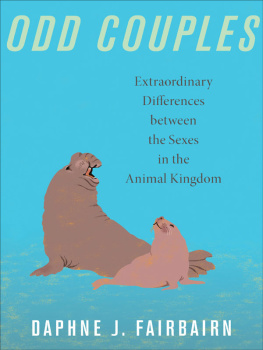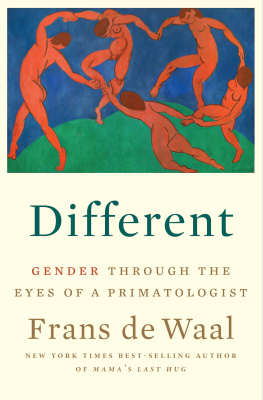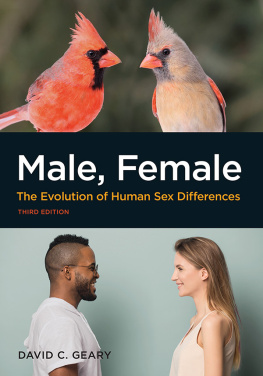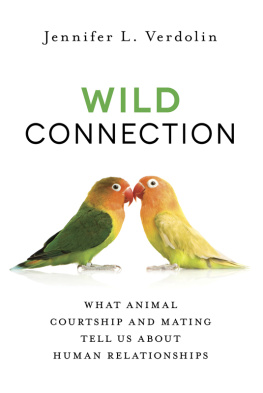ODD COUPLES
ODD COUPLES
Extraordinary Differences between the Sexes in the Animal Kingdom
DAPHNE J. FAIRBAIRN
PRINCETON UNIVERSITY PRESS
Princeton and Oxford
Copyright 2013 by Princeton University Press
Published by Princeton University Press, 41 William Street,
Princeton, New Jersey 08540
In the United Kingdom: Princeton University Press, 6 Oxford Street, Woodstock, Oxfordshire OX20 1TW
press.princeton.edu
Jacket illustration Gwenda Kaczor/Marlena Agency.
All Rights Reserved
ISBN 978-0-691-14196-1
British Library Cataloging-in-Publication Data is available
This book has been composed in Garamond Premier Pro and Helvetica Neue LT Std
Printed on acid-free paper.
Printed in the United States of America
1 3 5 7 9 10 8 6 4 2
FOR ALL THE ANIMALS
CONTENTS
ODD COUPLES
CHAPTER 1
Introduction
I spent my earliest days as a professional biologist happily tramping through the forests of southern Canada recording the survival, reproduction, and movement patterns of tiny mice that make their living among the detritus of the forest floor. My study subjects were the big-eared, dark-eyed deer mice that so often plague country cabins, apparently preferring the security and constant availability of food in human habitations to the perils of life in the wild. The official motivation for my study was to determine what causes the numbers of mice in a given population to fluctuate over time, and this, in turn, was motivated by the general question of what determines the numbers of individuals in any animal species. This was (and remains) a laudable goal, and I set forth on the study with full confidence in its scholarly legitimacy. Nevertheless, like most field biologists, I had chosen this type of research partly because it allowed me to spend much of my time out in the natural world rather than standing at a laboratory bench or hunched over a microscope. I had always been fascinated with the lives of wild creatures, and spending my time in the woods discovering how mice get through life seemed like just the ticket.
I captured my subjects in small metal boxes that my assistants and I placed strategically along mouse highways or close to mouse burrows. To entice the mice to enter our boxes, each was packed with a handful of nutritious seeds, a large dab of peanut butter, and a generous wad of cotton batting that the occupant invariably fluffed into a warm nest. The boxes were fitted with trap doors that closed when a mouse entered, and so we were able to catch the mice alive and release them again unharmed. The first time we caught a given mouse we would put a numbered, metal tag in its ear (much like a personalized ear stud) so that we could identify it when we caught it again. Our boxes were mouse magnets, and we caught hundreds of individuals, following many through most of their lives. To find out more about their individual personalities, I also brought each mouse into the laboratory for several nights (these are nocturnal mice) and ran it through a series of behavioral tests before taking it back to its capture site in the wild. Through all of this I got to know many of my mice quite well, and I was always delighted when old friends jumped out of their trap boxes in the cool of a morning. Once a mouse had finally disappeared from my study area, I would go back through my trapping records and reconstruct its life history. I could see where it had probably been born, where it traveled during its life, and how long it lived. If the mouse was a female I could tell when she was ready to mate, when and how often she had been pregnant and gave birth, and for how long she nursed her litters. My reproductive information was sketchier for males, but I could at least tell when they were ready and eager to mate.
Although my study was ostensibly designed to predict population numbers, as I got to know my mice I became increasingly absorbed by the obvious differences among themand particularly by the different ways that males and females functioned in the population. For example, my females faced many hazards associated with pregnancy and lactation, and many died or lost their litters due to cold, rainy weather or lack of food. In contrast, my males ignored their offspring and spent the reproductive season searching for receptive females and interacting aggressively with other males. Their greatest hazard seemed to be displacement by more aggressive rivals. Although the numbers of both sexes showed similar seasonal fluctuations, it became clear to me that this demographic similarity masked profound and fascinating differences between the sexes. As it turns out, this revelation set the course for much of my future research and ultimately provided the motivation for this book.
Ive come a long way since my deer mouse days. I now ask questions about the evolution and adaptive significance of animal characteristics rather than about population sizes and demography, and several years as a fisheries biologist followed by several decades studying various insects and spiders have expanded my animal horizons beyond the familiar world of temperate mammals. Nevertheless, the differences between males and females that emerged so strongly in my studies of deer mice have remained a persistent theme. Time and again I have discovered how different life is for males and females in the natural world. The sex of animals affects their morphology, life history, behavior, and ecology, and this is true throughout the animal kingdom. The modest differences I observed in deer mice are trumped many times over by much more sexually dimorphic species in many different animal lineages. In some of these species the sexes differ so much that they would never be recognized as belonging to the same species had they not been observed actually mating or emerging from the same batch of eggs. In this book I ask why sexual differences are such a pervasive and significant part of the fabric of animal variation and, in particular, why males and females have come to differ to truly extraordinary degrees in some animal lineages.
I answer these questions by looking at sexual differences across the animal kingdom with emphasis on species where the differences are at the extremes of the distribution. These extraordinary species are particularly apt examples because they so clearly illustrate the division of reproductive function between the sexes and the extremes to which each sex can go to perfect its role. At one extreme are species in which males are large, muscular despots defending harems of much smaller females against constant challenges from rival males, whereas at the other extreme are species in which the females are solitary, large, and fierce, while their mates are minuscule sexual parasites capable of little more than producing sperm. My aim is to reveal what life is like for males and females at both ends of this continuum and to explain why such extreme differences have evolved.
As an evolutionary biologist I take an overtly Darwinian approach to understanding sexual differences. The basic assumption of this approach is that sexual differences are adaptations that increase the success of males and females in their respective reproductive roles. The currency of evolutionary adaptation is Darwinian fitness, which in this context means the The implication of relevance here is that we expect the traits typical of males to enhance male fitness, whereas those typical of females should enhance female fitness. In other words we expect the trait distributions typical of each sex to be adaptive for that sex.
In studies of sexual differences one type of selection has received particular attention, and that is selection that acts through differential success in acquiring mates. Darwin coined the term sexual selection for this type of selection, and he described its importance in the evolution of secondary sexual traits, particularly in males. He presented copious evidence that males in many species are adapted for success in competition for mating opportunities and that many exaggerated male traits such as elaborate plumage, robust horns and antlers, and courtship songs and behaviors can be understood as consequences of sexual selection. Conversely, he argued that sexual selection was likely to be much less important in females, although he speculated that mate choice by males may have influenced the evolution of secondary sexual traits in human females.
Next page







